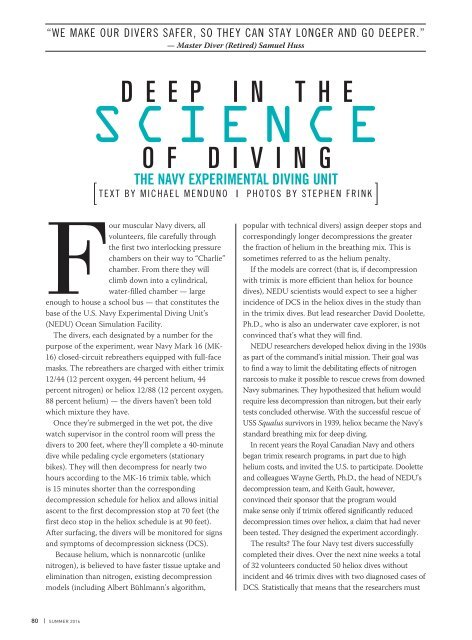AD 2016 Q3
Alert Diver is the dive industry’s leading publication. Featuring DAN’s core content of dive safety, research, education and medical information, each issue is a must-read reference, archived and shared by passionate scuba enthusiasts. In addition, Alert Diver showcases fascinating dive destinations and marine environmental topics through images from the world’s greatest underwater photographers and stories from the most experienced and eloquent dive journalists in the business.
Alert Diver is the dive industry’s leading publication. Featuring DAN’s core content of dive safety, research, education and medical information, each issue is a must-read reference, archived and shared by passionate scuba enthusiasts. In addition, Alert Diver showcases fascinating dive destinations and marine environmental topics through images from the world’s greatest underwater photographers and stories from the most experienced and eloquent dive journalists in the business.
Create successful ePaper yourself
Turn your PDF publications into a flip-book with our unique Google optimized e-Paper software.
“WE MAKE OUR DIVERS SAFER, SO THEY CAN STAY LONGER AND GO DEEPER.”<br />
— Master Diver (Retired) Samuel Huss<br />
D E E P I N T H E<br />
SCIENCE<br />
O F D I V I N G<br />
THE NAVY EXPERIMENTAL DIVING UNIT<br />
[ TEXT BY MICHAEL MENDUNO | PHOTOS BY STEPHEN FRINK<br />
[<br />
Four muscular Navy divers, all<br />
volunteers, file carefully through<br />
the first two interlocking pressure<br />
chambers on their way to “Charlie”<br />
chamber. From there they will<br />
climb down into a cylindrical,<br />
water-filled chamber — large<br />
enough to house a school bus — that constitutes the<br />
base of the U.S. Navy Experimental Diving Unit’s<br />
(NEDU) Ocean Simulation Facility.<br />
The divers, each designated by a number for the<br />
purpose of the experiment, wear Navy Mark 16 (MK-<br />
16) closed-circuit rebreathers equipped with full-face<br />
masks. The rebreathers are charged with either trimix<br />
12/44 (12 percent oxygen, 44 percent helium, 44<br />
percent nitrogen) or heliox 12/88 (12 percent oxygen,<br />
88 percent helium) — the divers haven’t been told<br />
which mixture they have.<br />
Once they’re submerged in the wet pot, the dive<br />
watch supervisor in the control room will press the<br />
divers to 200 feet, where they’ll complete a 40-minute<br />
dive while pedaling cycle ergometers (stationary<br />
bikes). They will then decompress for nearly two<br />
hours according to the MK-16 trimix table, which<br />
is 15 minutes shorter than the corresponding<br />
decompression schedule for heliox and allows initial<br />
ascent to the first decompression stop at 70 feet (the<br />
first deco stop in the heliox schedule is at 90 feet).<br />
After surfacing, the divers will be monitored for signs<br />
and symptoms of decompression sickness (DCS).<br />
Because helium, which is nonnarcotic (unlike<br />
nitrogen), is believed to have faster tissue uptake and<br />
elimination than nitrogen, existing decompression<br />
models (including Albert Bühlmann’s algorithm,<br />
popular with technical divers) assign deeper stops and<br />
correspondingly longer decompressions the greater<br />
the fraction of helium in the breathing mix. This is<br />
sometimes referred to as the helium penalty.<br />
If the models are correct (that is, if decompression<br />
with trimix is more efficient than heliox for bounce<br />
dives), NEDU scientists would expect to see a higher<br />
incidence of DCS in the heliox dives in the study than<br />
in the trimix dives. But lead researcher David Doolette,<br />
Ph.D., who is also an underwater cave explorer, is not<br />
convinced that’s what they will find.<br />
NEDU researchers developed heliox diving in the 1930s<br />
as part of the command’s initial mission. Their goal was<br />
to find a way to limit the debilitating effects of nitrogen<br />
narcosis to make it possible to rescue crews from downed<br />
Navy submarines. They hypothesized that helium would<br />
require less decompression than nitrogen, but their early<br />
tests concluded otherwise. With the successful rescue of<br />
USS Squalus survivors in 1939, heliox became the Navy’s<br />
standard breathing mix for deep diving.<br />
In recent years the Royal Canadian Navy and others<br />
began trimix research programs, in part due to high<br />
helium costs, and invited the U.S. to participate. Doolette<br />
and colleagues Wayne Gerth, Ph.D., the head of NEDU’s<br />
decompression team, and Keith Gault, however,<br />
convinced their sponsor that the program would<br />
make sense only if trimix offered significantly reduced<br />
decompression times over heliox, a claim that had never<br />
been tested. They designed the experiment accordingly.<br />
The results? The four Navy test divers successfully<br />
completed their dives. Over the next nine weeks a total<br />
of 32 volunteers conducted 50 heliox dives without<br />
incident and 46 trimix dives with two diagnosed cases of<br />
DCS. Statistically that means that the researchers must<br />
80 | SUMMER <strong>2016</strong>









